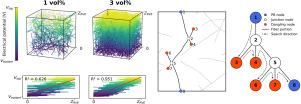Comprehensive quantification of electrically conductive networks with complex morphologies in carbon nanotube–polymer composites
IF 9.8
1区 材料科学
Q1 MATERIALS SCIENCE, COMPOSITES
引用次数: 0
Abstract
Carbon nanotube (CNT)-based polymer nanocomposites exhibit highly variable electrical properties due to the complex interplay between filler geometry and network formation. However, previous studies have largely lacked quantitative analysis of the internal network structure, and more importantly, the underlying mechanisms by which individual geometrical factors affect network connectivity remain poorly understood. To address this limitation, the present work provides a systematic investigation into the role of key CNT parameters on network morphology and resulting electrical conductivity. A Monte Carlo model was developed to incorporate realistic CNT features, including statistical length distributions and waviness represented via splines. The model was validated against experimental results and subsequently used to analyze the influence of CNT geometry on conductive network formation. A depth-first search algorithm was then applied to decompose the simulated networks into discrete conduction paths, enabling quantification of both path count and path length. Based on these findings, unified metrics are proposed that encapsulate the combined effects of multiple morphological factors and provide practical descriptors for predicting and optimizing the electrical performance of CNT networks.

碳纳米管-聚合物复合材料中复杂形态导电网络的综合定量研究
基于碳纳米管(CNT)的聚合物纳米复合材料由于填料几何形状和网络形成之间复杂的相互作用而表现出高度可变的电性能。然而,以往的研究在很大程度上缺乏对内部网络结构的定量分析,更重要的是,个体几何因素影响网络连通性的潜在机制仍然知之甚少。为了解决这一限制,本研究系统地研究了碳纳米管关键参数对网络形态和电导率的影响。开发了蒙特卡罗模型来结合现实的碳纳米管特征,包括统计长度分布和通过样条表示的波浪度。该模型与实验结果进行了验证,随后用于分析碳纳米管几何形状对导电网络形成的影响。然后应用深度优先搜索算法将模拟网络分解为离散的传导路径,从而实现路径计数和路径长度的量化。基于这些发现,提出了统一的度量,封装了多种形态因素的综合影响,并为预测和优化碳纳米管网络的电性能提供了实用的描述符。
本文章由计算机程序翻译,如有差异,请以英文原文为准。
求助全文
约1分钟内获得全文
求助全文
来源期刊

Composites Science and Technology
工程技术-材料科学:复合
CiteScore
16.20
自引率
9.90%
发文量
611
审稿时长
33 days
期刊介绍:
Composites Science and Technology publishes refereed original articles on the fundamental and applied science of engineering composites. The focus of this journal is on polymeric matrix composites with reinforcements/fillers ranging from nano- to macro-scale. CSTE encourages manuscripts reporting unique, innovative contributions to the physics, chemistry, materials science and applied mechanics aspects of advanced composites.
Besides traditional fiber reinforced composites, novel composites with significant potential for engineering applications are encouraged.
 求助内容:
求助内容: 应助结果提醒方式:
应助结果提醒方式:


